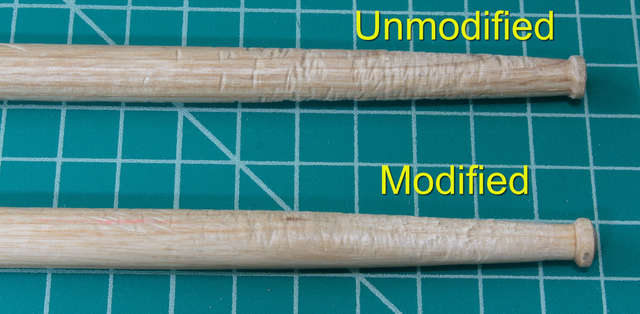
A while ago I wrote a post about modifying your drumsticks to help them last longer. I also have a video on the topic using another method that any drummer can execute, even on store-bought sticks without any tools.
It really will make your drumsticks last longer, sound better and get you all the ladies (guys).
Let me show you the results and benefits of the modification.
Contents
Pre-face

Since the original post, I’ve started shaving one side of the nub. So the stick does not have a nub all the way around the stick, but instead there’s a light flat at one point. My thumb rests on the flat, and the nub falls between my index and middle fingers.
This helps me not rotate the stick while playing, and is a big part of this post. See the image above.
This modification to the modification was present during testing, and I’ve been using this change literally since the day of the original post.
The method in this video prevents rotation as well, so you’re save with that method.
Introduction

The upper stick is a drum stick I made from the same piece of ash, directly adjacent on the tree to the stick below.
The lower stick is modified with the ‘nub’ that controls both the striking side of the stick and the fulcrum of the stick. Both of these increase tonal consistency and longevity of the stick.
I played in 4 minute sections of the exact same looped song. After the song ended I switched the sticks in each hand.
The track was played through 5 times per stick configuration for 10 total plays and 41 minutes and 10 seconds of playing.
Analysis

Let’s break down the differences between the sticks.
Unmodified stick
The upper stick is unmodified. The stick freely moves while playing both rotationally and along the length.
- The wood is dented around the circumference of the stick
- There are significant detents in the stick extending 5”/13cm from the tip
- The resulting taper is consistent
- There is consistent chipping along the shoulder. On location (unshown) has a large chip of wood missing
- The diameter of the stick 1”/2.5cm from the edge was reduced 0.031”/0.8mm from the starting size.
- The tip is clearly worn and missing a light chip (unshown)
- Stick slipped twice out of my hand while playing
Modified stick
The lower stick is modified. The stick does not rotate while playing and does not shift in the hand along the length
- The wood is dented on only the striking side of the stick
- Significant detents on the stick extend 2”/5cm from the tip
- The resulting taper is asymmetrical. Only the striking side has a light concave taper.
- Very light chipping only on the striking side
- The diameter of the stick 1”/2.5cm from the edge was reduced 0.020”/0.5mm from the starting size.
- Tip is in excellent condition
- No issues with stick grip
Assessment
The unmodified stick clearly shows more damage.
- The detents in the wood are offset which weaken the structure considerably (think about how you chop down a tree with offset entry points).
- There was more reduction in diameter on the unmodified stick.
- The unmodified stick had more grain lifting and a chip lost.
The modified stick’s wear pattern creates a light concavity from the consistent striking on 1 face. This concave shape is intuitively stronger than a consistent taper around the stick.
As the stick deteriorates the concave pattern also yields slightly along the side opposing the concavity. The feel of the stick changes noticeably and you can frequently changes sticks before a catastrophic breakage.
An un-tangible aspect of the test was that I felt I had much more control over the modified stick. I believe this is largely due to having a consistently located grip while playing.
Wear Profile explanation

Here you can see more clearly the type of wear each stick has.
-
Modified - The stick does not rotate and developes a single-sided concavity.
-
Unmodified - The stick rotates in the hand in use causing a rotationally symmetrical concavity to form around the whole stick
As the modified stick wears, it develops a consistent one-sided curve that increases it’s relative strength compared to a rotationally symmetrical reduction of diameter.
Hopefully with the image it’s intuitively clear how the Modified stick is stronger given the same taper and diameter through the wearing process.
Conclusion
At the very least, I believe that it’s fairly certain that the stick modification increases the longevity of the sticks fairly significantly.
I already know this since my modified sticks often last months and unmodified last a few weeks at best, but I found it interesting how quickly the differences visually became apparent.
Support Me!
This post took 2 hours to research, photograph, write and edit. If you appreciate the information presented then please consider joining patreon or donating!
